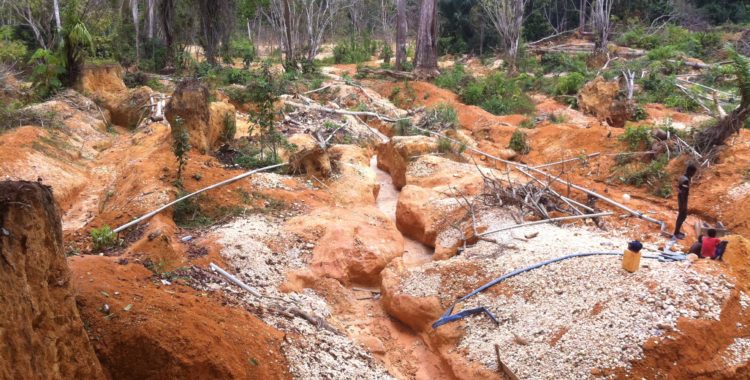Biodiversity loss, climate change and deforestation are existential threats to human beings, and it is incumbent on all individuals and businesses to do what we can to slow and stop this degradation of natural heritage. Although international action on these global challenges is gaining momentum, traction is slow in some parts of the mining and metals sector, especially in the incorporation of environmental due diligence into responsible sourcing. As a social venture, Levin Sources is committed to using its assets and abilities to drive sustainability through the minerals sector. We are delighted to announce that on the 11th April Levin Sources became a signatory of the New York Declaration on Forests, demonstrating our commitment to protect forests through our own work and our influence in the sector. This coincides with the publication of our work on Forest-Smart Mining, the conclusion of two years of research and consultation by Levin Sources, Fauna and Flora International and Swedish Geological AB.

The New York Declaration on Forests was announced in 2014 in order to slow and end forest loss. The declaration recognises that forests are essential for all life on Earth, as they provide half of the world’s oxygen, supply drinking water and pharmaceuticals, reduce disasters, provide livelihoods to 25% of the world population, are home to the majority of terrestrial biodiversity and provide cooking and heating materials for 60% of families worldwide.
Moreover, well-managed ecosystems and forests help mitigate the impacts of climate change and help us to adapt to the current climate hazards. Forests help stabilise the climate, act as carbon sinks and reduce social vulnerability. This is why forests are essential to successful mitigation, resilience, and adaptation policies. As Bruno Locatelli and Emilia Pramova from the Centre for International Forestry Research put it, “maintaining nature's capacity to buffer the impacts of climate change is often less costly than having to replace lost ecosystem functions by heavy infrastructure or technology”.
Currently, however, the world has lost 50% of its forests and deforestation is on-going. In DRC, primary forest loss was 38% higher in 2018 than average forest loss from 2011-2017. The consequences of forest loss do not only diminish biodiversity, but cause severe impacts for global climate change. Unsustainable agriculture, logging, wild fires, infrastructure, and mining are all leading causes of this deforestation.
Mining represents the fourth-largest driver of forest loss in developing countries. The transition to a green economy and the related increase in demand for low-carbon energy technologies cascade into huge demand for a multiplicity of minerals and metals. We will consume more metals in the 2020-2050 period than what we have consumed over the last 100 years. With this disproportionate growth in mineral demand, mining is set to expand in socially-, economically- and environmentally-sensitive forest areas, increasing the percentage of deforestation caused by mining. Currently, around 10 percent of the world’s forests lie within 50 kilometres of existing large-scale mines, rising to nearly 30 percent if mines under development or currently non-operational are considered.
Given the urgent need to protect and restore forests as a critical strategy for mitigating global climate change and supporting sustainable development, more “forest-smart” approaches are needed. We must remember that mining, if managed responsibly, can play a pivotal role in climate mitigation, resilience, and adaptation, helping achieve the SDGs and the Paris Agreement.
The World Bank Program on Forests (PROFOR) defines forest-smart as “a development approach that recognizes forests’ significance for sustaining growth across many sectors, including agriculture, energy, infrastructure, and water. It is sustainable and inclusive in nature, emphasising that forests are part of a broader landscape, and that changes in forest cover affect other land uses as well as the people living in that landscape. It transforms how sectors operate by identifying opportunities for mutual benefit and creating practical solutions that can be implemented at scale”. Adopting Forest-Smart Mining practices will help advance the New York Declaration on Forests’ overarching goals of halving deforestation by 2020, and ending it by 2030.
Over the past two years, PROFOR has funded three studies to identify good and bad mining practices, and develop a set of Forest-Smart Mining principles to support the development of context-specific Forest-Smart Mining approaches. These three reports have been finalised and are launching on 10th May, followed shortly after by publication on the PROFOR website.
Levin Sources, alongside Fauna & Flora International and Swedish Geological AB, and commissioned by the World Bank, has been leading the research of one of these three reports that focuses on artisanal and small-scale mining. As such, we are committed to push for the adoption of the Forest-Smart Mining principles, address the challenges and opportunities for better management of the environmental impacts of mining, and show leadership by also reducing our own carbon footprint and environmental impacts. Through becoming a signatory of the New York Declaration on Forests, we are making a public commitment to protect forests through our operations, our services, and our ability to influence. We would like to encourage our colleagues, partners, and broader community of practice in the minerals sector to become signatories, and to consider how they too – from whatever position they occupy - can lower their impacts on forests, and become champions for forest protection to the benefit of all.You can find more information on how to join the NYDF here. We would strongly encourage any mining or minerals sector actor, who wishes to do more to protect forests, to get in touch; we would love nothing more than to help you figure out how to do it.
References:
D Carrington, 2018, ‘Death by a thousand cuts’: vast expanse of rainforest lost in 2018, The Guardian, URL: https://www.theguardian.com/environment/2019/apr/25/death-by-a-thousand-cuts-vast-expanse-rainforest-lost-in-2018
N Hosonuma, M Herold, V De Sy, R S De Fries, M Brockhaus, L Verchot, A Angelsen and E Romjin, 2012, An assessment of deforestation and forest degradation drivers in developing countries, Environmental Research Letters, Volume 7, Number 4, URL: https://iopscience.iop.org/article/10.1088/1748-9326/7/4/044009/meta



